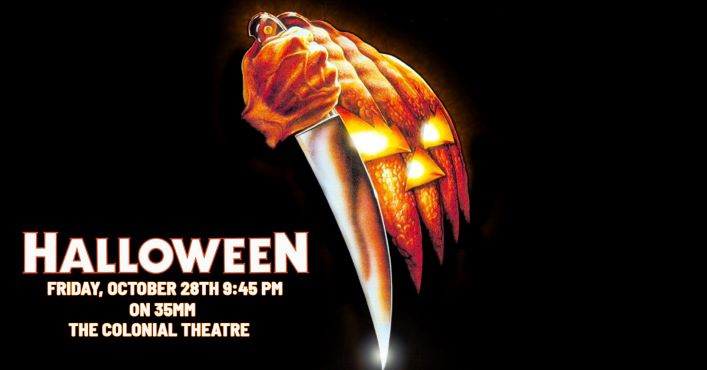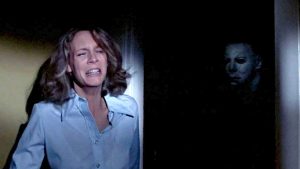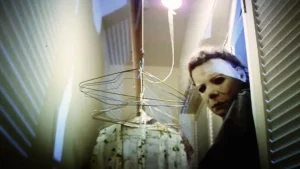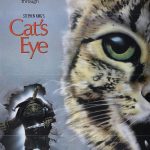”Halloween (1978)”
- movieslovers
- November 7, 2024

“Halloween” (1978) is a seminal horror film directed by John Carpenter, starring Jamie Lee Curtis in her film debut as Laurie Strode and Donald Pleasence as Dr. Sam Loomis. This low-budget slasher film became a groundbreaking entry in the horror genre, defining many conventions that would come to characterize slasher films in the decades to follow. With its iconic villain, Michael Myers, and a chilling, minimalist score, Halloween has become a classic, known for its suspense, simplicity, and terrifying atmosphere.
Plot Summary
The film opens on Halloween night in 1963, in the fictional town of Haddonfield, Illinois, where a young Michael Myers murders his older sister, Judith, in cold blood. Michael is institutionalized in a mental hospital, where he spends the next 15 years in silence. In 1978, Michael escapes from the hospital and returns to Haddonfield to continue his killing spree.
Dr. Sam Loomis (Donald Pleasence), Michael’s psychiatrist, knows the danger he poses and attempts to track him down before he can hurt anyone. Meanwhile, Laurie Strode (Jamie Lee Curtis), a high school student, begins to notice strange things happening, sensing that she’s being followed. On Halloween night, Michael starts stalking and killing Laurie’s friends, leaving her to face him alone in a harrowing final showdown.
Armed with only her wits, Laurie fights to survive as Michael hunts her relentlessly. Dr. Loomis arrives just in time to save her, shooting Michael multiple times, but in the film’s final moments, Michael mysteriously disappears, leaving an open ending that suggests evil is never truly vanquished.
Key Themes
- The Nature of Evil: Michael Myers is depicted as the embodiment of pure evil, a force with no apparent motivation or humanity. Dr. Loomis refers to him as “purely and simply evil,” highlighting a theme of fear that is existential and unexplainable.
- Survival and Final Girl Trope: Laurie Strode is often seen as the archetypal “final girl” in horror, embodying innocence and resourcefulness. Her determination and intelligence help her survive Michael’s attacks, establishing a standard for heroines in slasher films.
- Fear of the Unknown: Michael’s mask and his silent, emotionless demeanor make him a terrifying figure. The fact that he has no clear motive adds to his menace, creating a fear rooted in the unknown.
- Suburban Vulnerability: Set in a seemingly safe, suburban neighborhood, the film brings horror into an ordinary setting, suggesting that terror can strike anywhere, even in the most unsuspecting places.
Iconic Elements
- Michael Myers and the Mask: Michael’s blank white mask and jumpsuit have become iconic symbols in horror. The mask’s expressionless quality makes him a faceless, terrifying force, representing fear itself.
- The Score: John Carpenter’s haunting, minimalist score, composed on a synthesizer, uses simple piano notes to build tension and is one of the most recognizable horror themes in film history.
- Suspense Over Gore: Unlike many horror films that followed, Halloween relies heavily on suspense, atmosphere, and careful pacing rather than explicit gore, creating a psychological tension that has lasting power.
Performances
Jamie Lee Curtis, in her debut role, delivers a memorable performance as Laurie Strode, a character who would go on to become one of horror’s most iconic heroines. Curtis’s portrayal of Laurie combines vulnerability with strength, and her performance set the standard for “final girls” in horror. Donald Pleasence’s role as Dr. Loomis provides a sense of urgency and gravity, as he serves as the voice of warning and the embodiment of the audience’s fears about Michael’s nature.
Reception and Legacy
Halloween was a major success, both critically and commercially, and became one of the most profitable independent films of its time. Critics praised Carpenter’s direction, the film’s suspenseful pacing, and its effective use of atmosphere. The film spawned numerous sequels, reboots, and a long-lasting franchise, solidifying Michael Myers as a horror icon.
The legacy of Halloween is far-reaching, inspiring an entire genre of slasher films that followed, including Friday the 13th, A Nightmare on Elm Street, and Scream. The “final girl” trope, the concept of the masked, motiveless killer, and the use of suspense over gore all became hallmarks of the genre due to Halloween’s influence.
Cast and Crew
- Director: John Carpenter
- Writer: John Carpenter and Debra Hill
- Cast:
- Jamie Lee Curtis as Laurie Strode
- Donald Pleasence as Dr. Sam Loomis
- Nick Castle as Michael Myers (The Shape)
- P.J. Soles as Lynda
- Nancy Kyes as Annie
Fun Facts
- The iconic mask worn by Michael Myers is a modified Captain Kirk mask (of Star Trek fame) painted white, adding to its haunting appearance.
- The film was shot on a tight budget of around $300,000, and many props and costumes were sourced inexpensively, including the mask, which cost only a few dollars.
- Jamie Lee Curtis was cast partly because of her mother, Janet Leigh, who starred in Psycho (1960), as Carpenter thought it would be a nod to horror fans.
Conclusion
Halloween (1978) remains a masterpiece of horror cinema, celebrated for its suspense, minimalistic approach, and enduring influence on the genre. With its unforgettable villain, eerie score, and pioneering direction, the film has become a Halloween staple, revisited by horror fans year after year. Its lasting impact is a testament to John Carpenter’s craftsmanship, showing how atmosphere, storytelling, and a simple premise can create a haunting, timeless experience.











